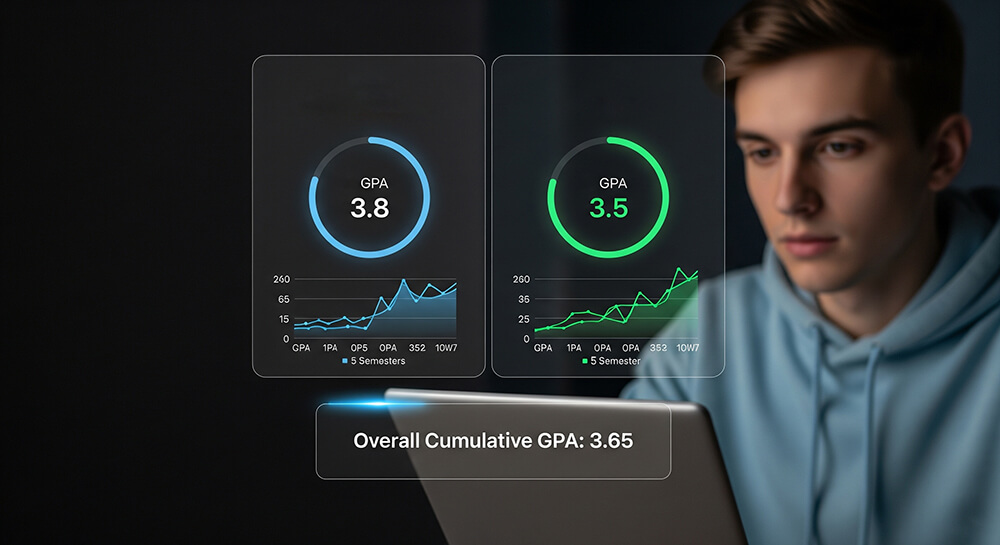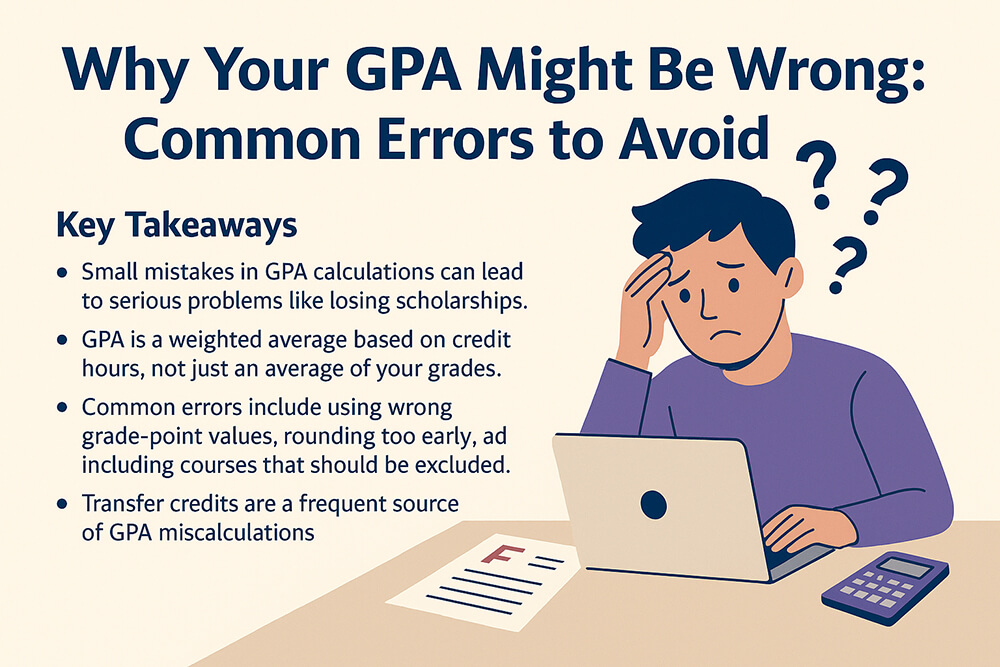Key Takeaways
| Feature | Description | Main Benefit |
|---|---|---|
| Scenario Planning | An Incomplete Grades Scenario Planner lets you see how different final grades (A, B, C) will change your overall GPA. | Removes uncertainty and helps you set clear academic targets. |
| GPA Impact | An incomplete ("I") grade is temporary and does not affect your GPA until a final grade is submitted. | Gives you time to complete work without an immediate GPA penalty. |
| Strategic Decisions | By projecting outcomes, you can decide whether to aim for an A to boost your GPA or secure a B to focus on other courses. | Empowers you to manage your workload and academic goals effectively. |
| Avoids Surprises | The tool prevents final grade surprises by showing you the exact impact of your performance on your cumulative GPA. | Reduces stress and helps you stay in control of your academic standing. |
What is an Incomplete Grade?
An incomplete grade, often shown as an "I" on a transcript, is a temporary mark given to a student who has not finished all course requirements by the end of a semester. This is usually granted for valid reasons, like an illness or family emergency, that prevent a student from completing a small amount of remaining work. It is not a permanent grade but a placeholder. The student must arrange with the instructor to complete the coursework within a specific timeframe, often by the next semester.
An Incomplete Grades Scenario Planner is a tool designed to help you see how your final grade in that course will impact your overall GPA.
How Incomplete Grades Affect Your GPA
Initially, an incomplete grade does not affect your GPA. It does not have any grade points associated with it, so it is not included in GPA calculations. However, this is only temporary. Once you complete the required work, the "I" is replaced with a final letter grade (like A, B, or C). This new grade is then factored into your cumulative GPA. If you fail to complete the work by the deadline, the "I" often turns into an "F," which can significantly lower your GPA.
Understanding how quality points vs. GPA explained is key to seeing how that final grade will shift your average. Similarly, its effect is different from how pass/fail grades impact your GPA, as those often don't assign grade points at all.
Using a Planner for Different Scenarios
An incomplete grade creates uncertainty. A scenario planner removes this doubt by letting you test different outcomes. You can input a potential final grade for your incomplete course and see how it would change your cumulative GPA. For example, you can see the difference between getting an A versus a B. This helps you set a clear goal for your remaining work.
Tools like a mid-term grade projection slider offer similar forward-looking insights. By visiting www.thegpacalculator.com, you can access calculators that make these projections simple and clear.
The GPA Calculation Formula Explained
Your GPA is calculated by dividing your total quality points by the total number of credit hours. Each letter grade has a point value (e.g., A=4, B=3). The formula is simple: (Grade Points × Credit Hours) / Total Credit Hours. When you have an incomplete grade, those credits are temporarily excluded. Once you receive a final grade, the new quality points and credits are added to the calculation.
A GPA formula guide can provide more detail on this process. Knowing how to calculate GPA and understanding the role of a credit hour weighting GPA guide puts you in control of your academic planning.
Planning for Weighted vs. Unweighted GPA
The final grade from an incomplete course can affect both your weighted and unweighted GPA. An unweighted GPA treats all classes equally, typically on a 4.0 scale. A weighted GPA gives more weight to advanced courses like AP or Honors. If your incomplete grade is in a weighted course, the final grade will have a larger impact on your weighted GPA.
It's helpful to explore weighted vs unweighted GPA differences. A GPA weighting guide for Honors/AP can clarify how these grades are treated, while a weighted vs unweighted GPA calculator can show you the exact numbers. Also, be aware of common weighted GPA myths debunked to ensure your planning is accurate.
From High School to College: Managing Incompletes
Both high school and college students can receive incomplete grades, but the stakes are often higher in college. In high school, a GPA is crucial for college applications. In college, it affects eligibility for scholarships, honors programs, and graduate school. A scenario planner is useful in both settings. A high schooler can see how a final grade will impact their chances for admission, while a college student can plan their path to graduation or advanced degrees.
A high school GPA calculator helps younger students, while a college GPA calculator is essential for those in higher education. Tools like a freshman year GPA predictor can also set the stage for success.
Special Cases: Transfer Credits and Dual Degrees
Students with complex academic histories face unique challenges with incomplete grades. If you are a transfer student, an incomplete grade from a previous institution may need to be resolved before credits are accepted. A transfer credits GPA integrator can help you see how these grades will merge with your new GPA.
For those pursuing two degrees, a dual degree GPA splitter is a useful tool for managing academic requirements for both programs. Similarly, students nearing graduation might use a last 60 credits GPA calculator to ensure they meet final requirements.
Avoiding Common GPA Calculation Mistakes
Manually calculating the impact of a future grade can lead to errors. You might forget to factor in credit hours correctly or use the wrong grade point value. Using an incomplete grade scenario planner helps you avoid these common GPA calculation errors to avoid. The tool automates the math, ensuring you get an accurate picture of your potential GPA. This allows you to focus on completing your coursework instead of worrying about calculation mistakes.
A transcript GPA audit guide can also help you find and correct any past discrepancies to ensure your starting GPA is accurate.
Frequently Asked Questions (FAQ)
What happens if I don't complete the work for an incomplete grade? If you do not finish the required work by the deadline set by your instructor, the "I" grade will typically be converted to an "F" or a failing grade. This will then be factored into your GPA and can lower it significantly.
Can an incomplete grade prevent me from making the Dean's List? Yes, it can. Eligibility for honors like the Dean's List often requires a certain number of completed credits within a semester. Since an incomplete course is not officially completed, it may affect your eligibility. A Dean's list eligibility checker can help you determine the specific requirements.
How does my school convert my final letter grade to a GPA point? Most schools use a standard 4.0 scale where A=4.0, B=3.0, C=2.0, D=1.0, and F=0. However, some institutions use plus and minus grades (like B+ = 3.33). A letter to point GPA conversion guide can show you the specific values your school uses.
What if I need to repeat the course? If you end up with a poor grade after the incomplete is resolved, you may have the option to retake the class. School policies vary on how the new grade replaces the old one in your GPA. A repeat course GPA recalculator can help you understand the potential impact.








